
Nudibranchs are a group of soft-bodied, marine gastropod molluscs which shed their shells after their larval stage. They are noted for their often extraordinary colours and striking forms, and they have been given colourful nicknames to match, such as "clown," "marigold," "splendid," "dancer," "dragon," or "sea rabbit." Currently, about 3,000 valid species of nudibranchs are known.
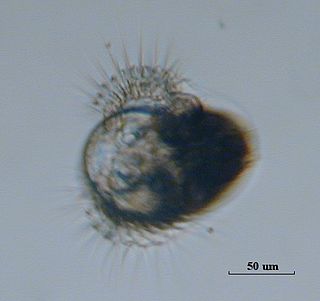
A veliger is the planktonic larva of many kinds of sea snails and freshwater snails, as well as most bivalve molluscs (clams) and tusk shells.

Glaucus atlanticus is a species of small, blue sea slug, a pelagic aeolid nudibranch, a shell-less gastropod mollusk in the family Glaucidae.

Paralabrax clathratus, the kelp bass, bull bass or calico bass, is a species of marine ray-finned fish, a sea bass from the subfamily Serraninae, classified as part of the family Serranidae which includes the groupers and anthias. It is found in the eastern North Pacific Ocean where it is an important species for both recreational and commercial fisheries.

Fiona pinnata, common name Fiona, is a species of small pelagic nudibranch, a marine gastropod mollusk in the superfamily Fionoidea. This nudibranch species lives worldwide on floating objects on seas, and feeds mainly on barnacles, specifically goose barnacles in the genus Lepas.

Aeolidia papillosa, known as the common grey sea slug, is a species of nudibranch in the family Aeolidiidae.

Nembrotha lineolata is a species of nudibranch, a sea slug, a marine gastropod mollusk in the family Polyceridae. It is found in shallow water in the Indo-Pacific. It was first described in 1905 by the Danish malacologist Rudolph Bergh. The type locality is Selayar Island, Indonesia.
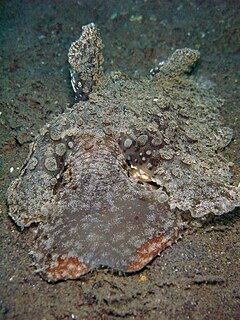
Melibe is a genus of sea slugs, nudibranchs, marine gastropod mollusks in the family Tethydidae.

Tritonicula hamnerorum is a species of dendronotid nudibranch. It is a marine gastropod mollusc in the family Tritoniidae. A number of Caribbean species of Tritonia were moved to a new genus Tritonicula in 2020 as a result of an integrative taxonomic study of the family Tritoniidae.

Tethys fimbria is a species of predatory sea slug, a nudibranch, a marine gastropod mollusk in the family Tethydidae.
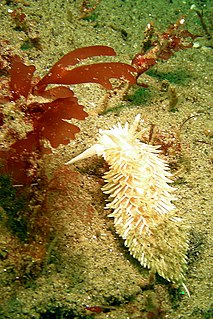
Ziminella salmonacea, common name the salmon aeolis, is a species of sea slug, an aeolid nudibranch, a marine gastropod mollusc in the family Paracoryphellidae.

Berghia is a genus of sea slugs, aeolid nudibranchs. They are shell-less marine gastropod molluscs in the family Aeolidiidae. They are covered in cerata which give them their unique tentacle look and color. Berghia are commonly found in shallow waters and their diet consists of strictly Aiptasia Anemone. This genus is now commonly used commercially to fight off Anemone populations in fish tanks.
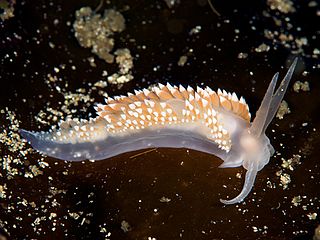
Coryphella verrucosa, is a species of sea slug, an aeolid nudibranch, a marine gastropod mollusc in the family Flabellinidae. It is found on either side of the northern part of the Atlantic Ocean.

Coryphellina rubrolineata is a species of sea slug, an aeolid nudibranch, a marine heterobranch mollusc in the family Flabellinidae.

Kelletia kelletii, common name Kellet's whelk, is a species of large sea snail, a whelk, a marine gastropod mollusc in the family Buccinidae, the true whelks.

Berghia stephanieae is a species of sea slug, an aeolid nudibranch. It is a marine gastropod mollusc in the family Aeolidiidae. It was previously known as Aeolidiella stephanieae.

Aeolidiella alderi is a species of sea slug, an aeolid nudibranch in the family Aeolidiidae. It is native to northwestern Europe where it occurs in the intertidal zone. It is a predator and feeds on sea anemones.

Gorgonorhynchus repens is a species of the proboscis worm in the subclass Heteronemertea and of the family Gorgonorhynchidae. It is to be found on the seabed in shallow water in the Pacific Ocean.
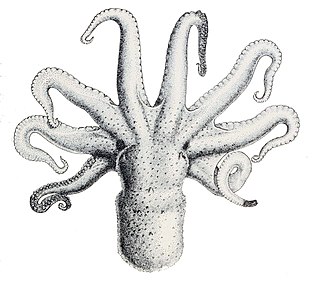
Octopus bimaculatus, commonly referred to as Verill's two-spot octopus, is a similar species to the Octopus bimaculoides, a species it is often mistaken for. The two can be distinguished by the difference in the blue and black chain-like pattern of the ocelli. O. bimaculatus hunt and feed on a diverse number of benthic organisms that also reside off the coast of Southern California. Once the octopus reaches sexual maturity, it shortly dies after mating, which is approximately 12–18 months after hatching. Embryonic development tends to be rapid due to this short lifespan of these organisms.
Janolus flavoanulatus is a sea slug species. The specific name is derived from Latin words flavus (“yellow”) and anulatus (“ringed”). These soft-bodied mollusks are known for their extraordinary colors and prominent forms. The first description of this species was reported by researcher Terry Gosliner, a leading researcher in the evolutionary history of nudibranchs. Upon his conducted research in the Philippines, Gosliner named Janolus flavoanulatus for its yellow ring around its cerata.





















